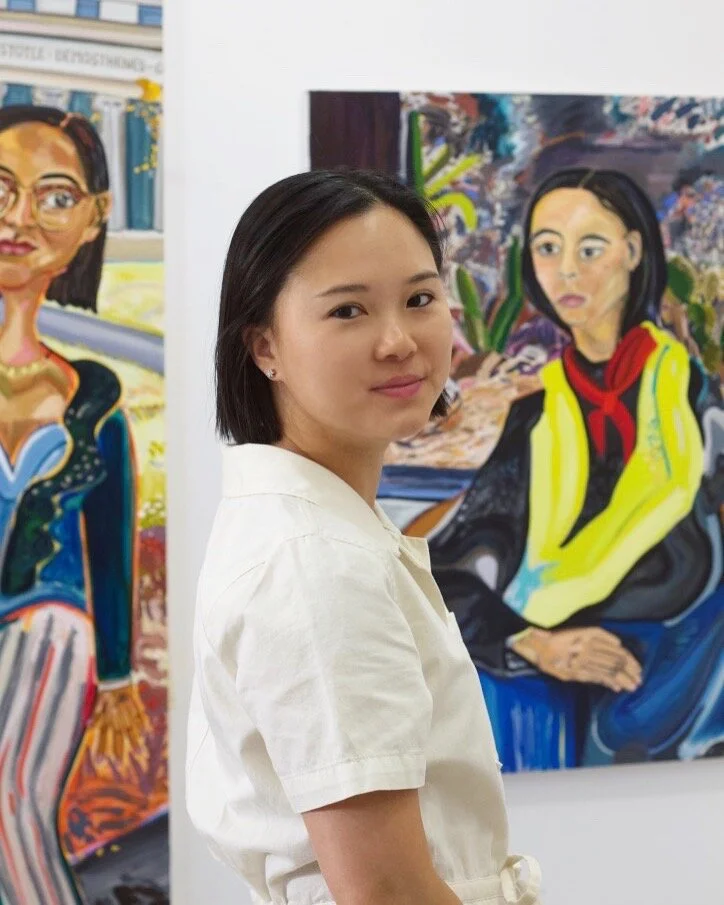In Conversation with Naudline Pierre: Painting her Personal History Phenomenally on the Canvas
And A Light Appeared, 2018. Oil on canvas. 40 x 30 inches. Courtesy of the artist.
In conversation with Naudline Pierre, a young, Brooklyn-based, oil painter combining color, passion, religion, sensuality, in a phenomenal manner on the canvas.
Gallery Gurls: I was really fascinated to read about your puritanical Protestant upbringing, can you talk about it and how did it enter your work?
Naudline Pierre: I was raised in a very religious home (my dad is a pastor), where religious tradition was the cornerstone of everything. Because of my surroundings, I grew up seeing the world through a very specific lens. The language and verbal imagery around me was very sanctified, very serious, and very unusual when taken out its cultural context. I grew up learning about the Biblical apocalypse, about visions, prophets, signs and symbols. The images around me were fantastical and even scary sometimes. Growing up in church, I saw really vivid events like my father and the church elders casting out demons. It was a colorful place for my imagination––full of fear, longing, and miracles––to take shape. I’m very grateful for my upbringing, experiences and influences.
“Growing up in church, I saw really vivid events like my father and the church elders casting out demons. It was a colorful place for my imagination––full of fear, longing, and miracles––to take shape.”
An Eternal Restlessness, 2018. Oil on canvas. 28 x 26 inches. Courtesy of the artist.
I love how you combine religious iconography, mythology, intimacy, sensuality in your paintings. Can you expand on this?
I’ve always been very aware of the unseen things in life. For example, you can’t see love but you can see its effects and feel what it’s like. So, in the work, I try to capture that. Through the work, I’ve found a way to understand my own existence while exploring an alternate reality on the canvas, and I’m using all sorts of elements to create my own visual language. In the process of painting, I’m always searching for a way to get at the rawest depiction of intimacy. Intimacy can exist in many places, it can be familial, romantic, or platonic. In the work, I’m creating my personal mythology and exploring these themes in this imagined world that I’ve put together, using religious iconography as a tool just like I use color and texture as tools.
Blessed Are The Blessed, 2018. Oil on canvas. 48 x 38 inches. Courtesy of the artist.
In a recent piece for The Cut, you said, "But now I feel like I’ve found a way to co-opt classical language, to subvert it in a way that can give me a feeling of agency." I love this statement, can you tell me more?
Well, I’m in love with a time in art history that I find extremely beautiful, but that also raises conflicting feelings for me. I am a figurative painter who is interested in looking at a moment in Eurocentric art history, roughly the 1400s–1600s. I’m looking back in time and using aspects of paintings made by people who are dead and gone, people who definitely did not make those paintings for me to look at––much less consume, understand, and enjoy. I’m taking that figurative language and making it mine through color, texture, my own stories, and by inserting my own body. As a painter using oil paint, I feel very engaged in the rich legacy of that material, which is the start of my co-opting a classical language.
I must say, I’m not thinking about how subversive the work is while I paint. That is not the most important thing for me. I’m thinking about what I want to see in the painting. The subversive element, I believe, is a by-product of me doing whatever I want on my surfaces, while acknowledging the ties to those grand mythological and religious paintings found in the canon.
I feel in control and powerful when I paint. I also feel soft and tender when I paint. I’ve created a world where I call the shots. There are moments when the painting itself guides me, and the material and colors respond to each other and let me know what my next move is.
“I feel in control and powerful when I paint. I also feel soft and tender when I paint. I’ve created a world where I call the shots.”
Closer Still, 2017. Oil on canvas. 48 x 38 inches. Courtesy of the artist.
What is next for you in 2018?
This is an exciting time for me. I’m now represented by the LA-based gallery, Shulamit Nazarian, who is presenting a two-person exhibition with myself and Amir Fallah at Expo Chicago at the end of September. I’m really looking forward to that. We’re also planning a 2019 solo exhibition in LA, so I’m also really looking forward to debuting a new body of work then.
Follow Naudline Pierre @cluvie










